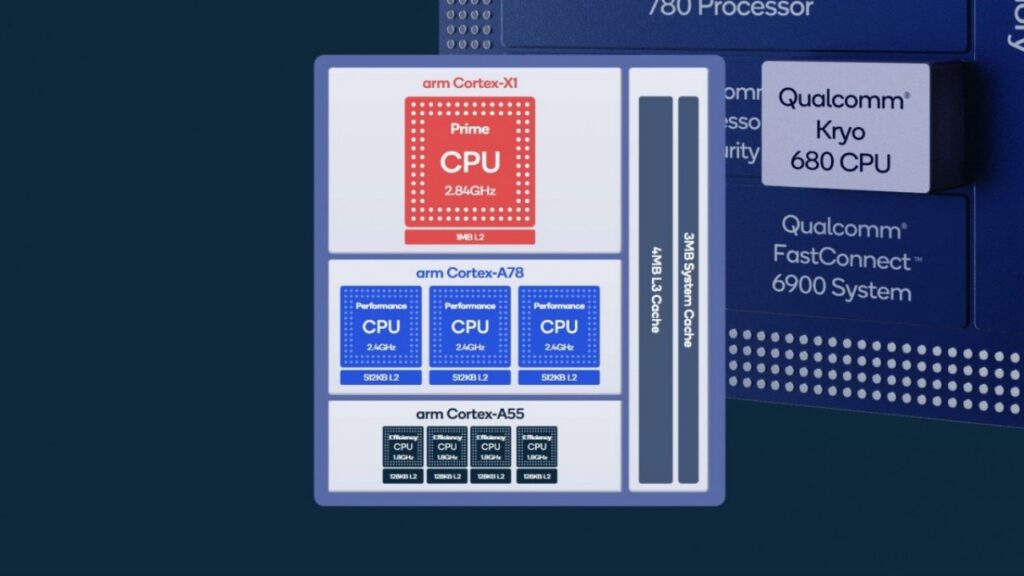Having a flagship as your daily driver is always a pleasure, and every year the computing power of these wearables gradually increases. From facial recognition to searching for voices on the web, today’s smartphone can do things that were unthinkable a decade ago.
The growth of the semiconductor industry is the most important factor in this change. When it comes to the silicon that powers your smartphones, Qualcomm is the name of the game, covering over 32% of the Android smartphone market.
Qualcomm updates its Snapdragon processors every year and, following the trend, is releasing a new Snapdragon 888 processor to power 2021 flagship ships – at least those released in the first half of the year.
If you’re considering buying a flagship and can’t decide between an 865+ and an 888 Snapdragon, you’ve come to the right place. In this article, we will talk about the new Snapdragon 888 and how it compares to the old Snapdragon 865+.
Also read : Snapdragon 865+ 5G vs. 865 5G vs. 855+ vs. 855
The SoC manufacturing process is a critical factor that affects the power consumption and processing performance of the chip. This manufacturing process reduces power consumption and increases computing power because more transistors can be etched into a single silicon.
The Snapdragon 865+ uses a 7 nanometer manufacturing process, while the new Snapdragon 888 uses a 5 nanometer process. This allows the 888 to offer a better performance ratio than the old 865+.
Although the Snapdragon SoC consists of multiple components, the processor performs all of the operating system’s computing tasks in order to function properly. A more powerful processor is therefore useful.
The Snapdragon 888 is the most powerful processor in Qualcomm’s portfolio. The Snapdragon 865+ and 888 both have an octa-core design with a three-cluster architecture, but use different ARM cores.
The 865+ features a powerful 3.1 GHz Cortex-A77 (Kryo 585 processor), three 2.42 GHz Gold Cortex-A77 cores and four low-power 1.80 GHz Silver Cortex-A55 cores.
The Snapdragon 888, on the other hand, uses a 2.84 GHz Cortex-X1 super core (Kryo 680 Prime CPU), four 1.80 GHz silver Cortex-A55 cores (Kryo 680 Efficiency CPU) and three 2.42 GHz gold Cortex-A78 cores (Kryo 680 Performance CPU).
 Source : Qualcomm
Source : Qualcomm
Although the two processors use different clock speeds, the Snapdragon 888 uses newer cores that offer better performance and power efficiency. In numbers, ARM says the Cortex A78 delivers 20% more power than the A77 with a budget of 1 watt.
At the same time, they take up 15% less space on silicon in a four-core configuration because each core is 5% smaller than the previous generation of processors. The new cores also consume 50% less power for the same performance as the old A77 cores.
The new Snapdragon 888 Cortex X1 kernel is the first processor developed for the CXC program. It provides integer calculations 23% faster than A78 cores and 30% faster than A77 cores. Due to the higher processing power of the X1, it consumes more power than the cores of the A78.
Qualcomm claims that the Kryo 680 package offers 15 percent more processing power than the Snapdragon 865+’s Kryo 585.
Also read : Helio P70 versus Snapdragon 660 : Which one is the best?
The Snapdragon 888 is powered by the Adreno 660, compared to the old Adreno 650 of the Snapdragon 865+. When it comes to GPU specs, Qualcomm gives a lot. At the same time, the company claims that graphics are 35% faster and energy efficiency has increased by 20%.
 Source : Qualcomm
Source : Qualcomm
The Snapdragon 888 features Qualcomm’s Fast Touch technology, which reduces touch latency by 20 percent. In addition, 888 devices can use the high-end Snapdragon gaming platform, allowing HDR games to run twice as fast.
It also supports 10-bit HDR rendering, which improves the game’s contrast ratios. The technology also brings desktop technologies, such as variable shadows, to mobile devices and allows users to update their GPU drivers, meaning users don’t have to wait for software updates to optimize the game.
Also read : Comparison of all Intel Processor Generations
The Snapdragon 888 runs on Qualcomm’s 580 ISP spectrum, an updated version of the earlier 480 ISP spectrum. With this new provider, the Snapdragon 888 can capture and process 2.7 gigapixels per second, equivalent to 120 continuous shots at 12 megapixels per second.
Compared to the previous supplier, this unit shows an improvement of about 35% and has three independent suppliers – one of more than 865. With this setting, 888 can record real-time 4k video from three cameras and benefit from 10-bit HDR recording.
 Source : Qualcomm
Source : Qualcomm
In addition, the chip features a new low-light architecture that improves low-light shooting. In addition, computerized HDR can be used when shooting 4k videos and AI-assisted autofocus has been added to this new provider.
Also read : Snapdragon 712 vs. 710 vs. 675
The biggest improvement in the Snapdragon 888 is in the area of AI processing, which improves the overall gaming, photography and networking experience, as AI algorithms are heavily used in these areas.
The Snapdragon 888 uses an all-new 780 hexagonal AI processor with a fused design that combines scalar, tensor and vector units in a single core, increasing the processing power of the AI chip. In addition, the AI core is connected to a 16 times larger memory block, allowing simultaneous access to more AI algorithms.
 Source : Qualcomm
Source : Qualcomm
The new AI core enables the Snapdragon to perform 26 trillion operations per second, a significant improvement over the old chip that could perform 15 trillion operations per second. The new chip can also perform tensor calculations at twice the speed, and measurement calculations have also been improved by 50%.
Although the computing power of the AI chip is very high, it delivers this performance by reducing power consumption by a factor of three compared to older generation processors.
 Source : Qualcomm
Source : Qualcomm
In addition to the new 780 hexagonal AI core, the Snapdragon 888 uses the second-generation Sensor Hub, a low-power AI core that runs AI algorithms in the background to enable features like Smart Wake-up to trigger words like Google OK and Screen Wake-up for motion detection.
The second generation sensor concentrator delivers up to 5 times the processing power while consuming less than a milliampere. Due to the energy efficiency of the sensitive node, artificial intelligence algorithms can be moved from the hexagonal core to the sensitive node to reduce energy consumption.
Also read : Logitech G-Hub vs. Logitech Gaming Software (LGS)
In terms of networking, the Snapdragon 888 uses the Snapdragon X60 5G modem, an enhanced version of the X55 modem that offers better connectivity to various service providers. It’s included with the X55 and offers technologies like WiFi 6E with speeds up to 3.6 gigabits per second.
In terms of security, the 888 is the first mobile processor to offer hypervisor support, allowing users to run independent instances of different operating systems on their device. This allows users to have two different profiles on the device, and if one is compromised, the other remains intact.

It is also equipped with Truepic technology, which allows the processor to print your fingerprints on photos captured with cryptographic keys, allowing the user to claim the authenticity of their image in case of copyright infringement.
The chip also features the latest version of fast charging technology, which Qualcomm says allows for a 50 percent charge in five minutes while delivering more than 100 watts of power. This protocol also allows for 70% more efficient charging and keeps devices 10 degrees cooler while charging.
 Source : Qualcomm
Source : Qualcomm
This protocol also provides eight levels of voltage protection, three levels of current protection, three levels of thermal protection, and overvoltage protection on the USB input at 25V, as well as regulation of extreme power above 30V.
Also read : How to check and restore clipboard history on Android?
Unlike what happens every year, Qualcomm published demo tests for devices using common benchmarking tools. Below is a comparison of the various benchmarks.

The Snapdragon 888 shows a 14.47% increase in multi-core performance. In terms of single-core performance, the Snapdragon 888 offers a 13.2% performance increase.

The Gfxbench shows a 30 percent improvement in GPU performance and is close to Qualcomm’s ability to deliver a relatively better gaming experience.

In terms of AI performance, the Snapdragon 888 offers three times the performance of the 865+.
Looking at the benchmarks, Qualcomm is living up to its performance claims and will surely add much more computing power to the 2021 flagship ships.
Below is a comparison of the points each transformer offers, so you can make an informed decision on which SoC is best for you.
| Category | Thunder Dragon 888 | Snapdragon 865+ |
|---|---|---|
| CPU | Cortex-X1 super core clocked at 2.84 GHz, four cortex-A55 cortex clocked at 1.80 GHz, and three cortex-A78 cortex clocked at 2.42 GHz. | Cortex-A77 cores clocked at 3.1 GHz, three Cortex-A77 cores clocked at 2.42 GHz and four low-power Cortex-A55 cores clocked at 1.80 GHz. |
| GPU | Adreno 660 | Adreno 650 |
| Lithography | 5 nm | 7 nm |
| Camera | Qualcomm Spectrum 580 PSP (triple PSP configuration) | Qualcomm 480 PSP spectrum (dual PSP tuning) |
| AI | Hexagon 780 Fused AI core | Hexagonal processor 698 |
| Security | Qualcomm Secure Processing Unit with Hypervisor and Truepic Technology | Qualcomm’s Secure Processing Module |
| Store | Fast charging 5 | Fast pricing 4+ |
| Memory | LP-DDR5 memory up to 3200 MHz | LP-DDR5 memory up to 2750 MHz |
Also read : OnePlus Band vs Mi Band 5 : Which one should I buy?

A technophile driven by curiosity. A bibliophile who likes to travel. An engineering graduate who enjoys programming and writing about new technologies. We cannot survive without coffee.
You can contact Nischay by email: [email protected].
Related Tags:
snapdragon 875 vs 888, snapdragon 875 vs 865 plus, snapdragon 888 vs 865 plus, snapdragon 865 vs 865, snapdragon 865 vs 865 plus, snapdragon 888 vs a14, snapdragon 865 vs a14, snapdragon 888 vs 865 benchmark










































































































